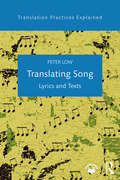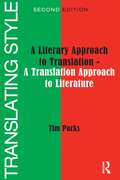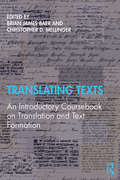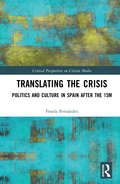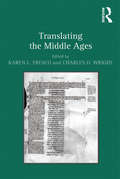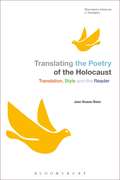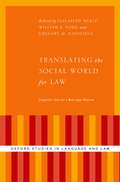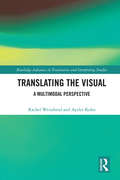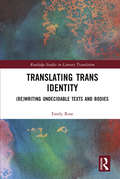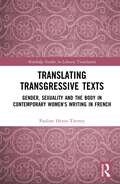- Table View
- List View
Translating Song: Lyrics and Texts (Translation Practices Explained)
by Peter LowThis engaging step-by-step guide prescribes effective strategies and tactics for translating a wide range of songs and other vocal music, from classical to contemporary. Focusing on best practice and with a variety of language examples, the book centres on four key themes: translating songs for a range of recipients and within different contexts (skopos theory) translating songs for reading on paper or on screens (surtitles and subtitles) "singable translations" and the Pentathlon Approach translating expressive texts. With a substantial introduction, six insightful chapters, further reading and a glossary of key terms (also available at https://www.routledge.com/9781138641792 and on the Routledge Translation Studies Portal), this lively and clear student-friendly guide is essential for students, researchers and practitioners involved in or studying the practice of translating music. This will also be an engaging read for musicians and all those interested in the study of music.
Translating Style: A Literary Approach to Translation - A Translation Approach to Literature
by Tim ParksArising from a dissatisfaction with blandly general or abstrusely theoretical approaches to translation, this book sets out to show, through detailed and lively analysis, what it really means to translate literary style. Combining linguistic and lit crit approaches, it proceeds through a series of interconnected chapters to analyse translations of the works of D.H. Lawrence, Virginia Woolf, James Joyce, Samuel Beckett, Henry Green and Barbara Pym. Each chapter thus becomes an illuminating critical essay on the author concerned, showing how divergences between original and translation tend to be of a different kind for each author depending on the nature of his or her inspiration. This new and thoroughly revised edition introduces a system of 'back translation' that now makes Tim Parks' highly-praised book reader friendly even for those with little or no Italian. An entirely new final chapter considers the profound effects that globalization and the search for an immediate international readership is having on both literary translation and literature itself.
Translating Style: A Literary Approach to Translation - A Translation Approach to Literature
by Tim ParksArising from a dissatisfaction with blandly general or abstrusely theoretical approaches to translation, this book sets out to show, through detailed and lively analysis, what it really means to translate literary style. Combining linguistic and lit crit approaches, it proceeds through a series of interconnected chapters to analyse translations of the works of D.H. Lawrence, Virginia Woolf, James Joyce, Samuel Beckett, Henry Green and Barbara Pym. Each chapter thus becomes an illuminating critical essay on the author concerned, showing how divergences between original and translation tend to be of a different kind for each author depending on the nature of his or her inspiration. This new and thoroughly revised edition introduces a system of 'back translation' that now makes Tim Parks' highly-praised book reader friendly even for those with little or no Italian. An entirely new final chapter considers the profound effects that globalization and the search for an immediate international readership is having on both literary translation and literature itself.
Translating Texts: An Introductory Coursebook on Translation and Text Formation
by Brian James Baer Christopher D. MellingerClear and accessible, this textbook provides a step-by-step guide to textual analysis for beginning translators and translation students. Covering a variety of text types, including business letters, recipes, and museum guides in six languages (Chinese, English, French, German, Russian, and Spanish), this book presents authentic, research-based materials to support translation among any of these languages. Translating Texts will provide beginning translators with greater text awareness, a critical skill for professional translators. Including discussions of the key theoretical texts underlying this text-centred approach to translation and sample rubrics for (self) assessment, this coursebook also provides easy instructions for creating additional corpora for other text types and in other languages. Ideal for both language-neutral and language-specific classroom settings, this is an essential text for undergraduate and graduate-level programs in modern languages and translation.
Translating Texts: An Introductory Coursebook on Translation and Text Formation
by Brian James Baer Christopher D. MellingerClear and accessible, this textbook provides a step-by-step guide to textual analysis for beginning translators and translation students. Covering a variety of text types, including business letters, recipes, and museum guides in six languages (Chinese, English, French, German, Russian, and Spanish), this book presents authentic, research-based materials to support translation among any of these languages. Translating Texts will provide beginning translators with greater text awareness, a critical skill for professional translators. Including discussions of the key theoretical texts underlying this text-centred approach to translation and sample rubrics for (self) assessment, this coursebook also provides easy instructions for creating additional corpora for other text types and in other languages. Ideal for both language-neutral and language-specific classroom settings, this is an essential text for undergraduate and graduate-level programs in modern languages and translation.
Translating the Crisis: Politics and Culture in Spain after the 15M (Critical Perspectives on Citizen Media)
by Fruela FernándezTranslating the Crisis discusses the multiple translation practices that shaped the 15M movement, also known as the indignados (‘outraged’), a series of mass demonstrations and occupations of squares that took place across Spain in 2011 and which played a central role in the recent global wave of popular protest. Through a study of the movement's cultural and intellectual impact, as well as some of its main political evolutions (namely Podemos and Barcelona en Comú), Fernández shows how translation has contributed to the dissemination of ideas and the expansion of political debates, produced new intellectual and political figures, and provided support to political projects. Drawing on fieldwork, interviews, and a large repertoire of sources in various languages, this monograph provides an in-depth study of the role of translation in the renewal of activist language, the development of political platforms, and the creation of new social references, while also presenting a critical perspective on its limitations and shortcomings. Combining first-hand experience of the Spanish reality with a keen transnational awareness, Fernández offers a nuanced, present-day perspective on the political events taking place in Spain and connects them with wider transformations across the world. This book is invaluable for scholars and researchers in Translation Studies, Spanish Studies, Social Movement Studies, and Politics.
Translating the Crisis: Politics and Culture in Spain after the 15M (Critical Perspectives on Citizen Media)
by Fruela FernándezTranslating the Crisis discusses the multiple translation practices that shaped the 15M movement, also known as the indignados (‘outraged’), a series of mass demonstrations and occupations of squares that took place across Spain in 2011 and which played a central role in the recent global wave of popular protest. Through a study of the movement's cultural and intellectual impact, as well as some of its main political evolutions (namely Podemos and Barcelona en Comú), Fernández shows how translation has contributed to the dissemination of ideas and the expansion of political debates, produced new intellectual and political figures, and provided support to political projects. Drawing on fieldwork, interviews, and a large repertoire of sources in various languages, this monograph provides an in-depth study of the role of translation in the renewal of activist language, the development of political platforms, and the creation of new social references, while also presenting a critical perspective on its limitations and shortcomings. Combining first-hand experience of the Spanish reality with a keen transnational awareness, Fernández offers a nuanced, present-day perspective on the political events taking place in Spain and connects them with wider transformations across the world. This book is invaluable for scholars and researchers in Translation Studies, Spanish Studies, Social Movement Studies, and Politics.
Translating the Jewish Freud: Psychoanalysis in Hebrew and Yiddish (Stanford Studies in Jewish History and Culture)
by Naomi SeidmanThere is an academic cottage industry on the "Jewish Freud," aiming to detect Jewish influences on Freud, his own feelings about being Jewish, and suppressed traces of Jewishness in his thought. This book takes a different approach, turning its gaze not on Freud but rather on those who seek out his concealed Jewishness. What is it that propels the scholarly aim to show Freud in a Jewish light? Naomi Seidman explores attempts to "touch" Freud (and other famous Jews) through Jewish languages, seeking out his Hebrew name or evidence that he knew some Yiddish. Tracing a history of this drive to bring Freud into Jewish range, Seidman also charts Freud's responses to (and jokes about) this desire. More specifically, she reads the reception and translation of Freud in Hebrew and Yiddish as instances of the desire to touch, feel, "rescue," and connect with the famous Professor from Vienna.
Translating the Jewish Freud: Psychoanalysis in Hebrew and Yiddish (Stanford Studies in Jewish History and Culture)
by Naomi SeidmanThere is an academic cottage industry on the "Jewish Freud," aiming to detect Jewish influences on Freud, his own feelings about being Jewish, and suppressed traces of Jewishness in his thought. This book takes a different approach, turning its gaze not on Freud but rather on those who seek out his concealed Jewishness. What is it that propels the scholarly aim to show Freud in a Jewish light? Naomi Seidman explores attempts to "touch" Freud (and other famous Jews) through Jewish languages, seeking out his Hebrew name or evidence that he knew some Yiddish. Tracing a history of this drive to bring Freud into Jewish range, Seidman also charts Freud's responses to (and jokes about) this desire. More specifically, she reads the reception and translation of Freud in Hebrew and Yiddish as instances of the desire to touch, feel, "rescue," and connect with the famous Professor from Vienna.
Translating the Language of Patents
by Françoise HerrmannThis book is a guide to translating the language of patents in view of avoiding costly translation errors. Errors that might hinder the examination process for granting patents, or that might make patents undefendable in a context of litigation.The 42 sections of this book each identify different provisions of the law for their relevance to translation. These provisions govern language uses, right down to the use of punctuation. Each of the sections present findings, both in terms of the relevant provisions identified, and their specific significance to translation. Exemplified translations focus on French and English, but when there is a consensus across Intellectual property systems, multilingual parallelism is highlighted. Wherever relevant, provisions of specific rules and regulations are presented and exemplified in the three official languages of the European Patent Office (EPO), English, French, and German and the three official languages of the United Nations World Intellectual Property Organization (WIPO), English, French, and Spanish.Written by an experienced teacher, patent translator, and author of the blog, Patents on the Soles of Your Shoes, this is a rigorously researched, authoritative, and comprehensive guide for all professional translators working on patents, and for students and translators working in legal translation. Accompanying e-resources are available on the Routledge Translation studies portal (routledgetranslationstudiesportal.com) including information on how to use this book in courses.
Translating the Language of Patents
by Françoise HerrmannThis book is a guide to translating the language of patents in view of avoiding costly translation errors. Errors that might hinder the examination process for granting patents, or that might make patents undefendable in a context of litigation.The 42 sections of this book each identify different provisions of the law for their relevance to translation. These provisions govern language uses, right down to the use of punctuation. Each of the sections present findings, both in terms of the relevant provisions identified, and their specific significance to translation. Exemplified translations focus on French and English, but when there is a consensus across Intellectual property systems, multilingual parallelism is highlighted. Wherever relevant, provisions of specific rules and regulations are presented and exemplified in the three official languages of the European Patent Office (EPO), English, French, and German and the three official languages of the United Nations World Intellectual Property Organization (WIPO), English, French, and Spanish.Written by an experienced teacher, patent translator, and author of the blog, Patents on the Soles of Your Shoes, this is a rigorously researched, authoritative, and comprehensive guide for all professional translators working on patents, and for students and translators working in legal translation. Accompanying e-resources are available on the Routledge Translation studies portal (routledgetranslationstudiesportal.com) including information on how to use this book in courses.
Translating the Literatures of Small European Nations
This book constitutes the most detailed and wide-ranging comparative study to date of how European literatures written in less well known languages try, through translation, to reach the wider world. Through case studies of over thirteen different national contexts as diverse as Bosnian, Catalan, Czech, Dutch, Maltese, Polish, Portuguese, Swedish and Serbian, it explores patterns and contrasts in approaches to supply-driven translation, cultural diplomacy, institutional support and international gate-keeping, while examining the particular fates of poetry, women’s writing and genre fiction, and the opportunities arising from trans-medial circulation, self-translation and translingualism and a more radical critique of power balances in the translation and publishing industries. Its comparative approach challenges both the narratives of uniqueness that arise from discrete national approaches and the narrative of tragic marginalization that prevails in world literary approaches. Instead, it uses an interdisciplinary mix of literary, historical, sociological, gender- and translation-studies approaches to illuminate the often pioneering, innovative thinking and strategies that mark these literatures as they take on the inequalities of globalization.
Translating the Middle Ages
by Karen L. FrescoDrawing on approaches from literary studies, history, linguistics, and art history, and ranging from Late Antiquity to the sixteenth century, this collection views 'translation' broadly as the adaptation and transmission of cultural inheritance. The essays explore translation in a variety of sources from manuscript to print culture and the creation of lexical databases. Several essays look at the practice of textual translation across languages, including the vernacularization of Latin literature in England, France, and Italy; the translation of Greek and Hebrew scientific terms into Arabic; and the use of Hebrew terms in anti-Jewish and anti-Muslim polemics. Other essays examine medieval translators' views and performance of translation, looking at Lydgate's translation of Greek myths through mental images rendered through rhetorical figures or at how printing transformed the rhetoric of intervernacular translation of chivalric romances. This collection also demonstrates translation as a key element in the construction of cultural and political identity in the Fet des Romains and Chester Whitsun Plays, and in the papacy's efforts to compete with Byzantium by controlling the translation of Greek writings.
Translating the Middle Ages
by Karen L. FrescoDrawing on approaches from literary studies, history, linguistics, and art history, and ranging from Late Antiquity to the sixteenth century, this collection views 'translation' broadly as the adaptation and transmission of cultural inheritance. The essays explore translation in a variety of sources from manuscript to print culture and the creation of lexical databases. Several essays look at the practice of textual translation across languages, including the vernacularization of Latin literature in England, France, and Italy; the translation of Greek and Hebrew scientific terms into Arabic; and the use of Hebrew terms in anti-Jewish and anti-Muslim polemics. Other essays examine medieval translators' views and performance of translation, looking at Lydgate's translation of Greek myths through mental images rendered through rhetorical figures or at how printing transformed the rhetoric of intervernacular translation of chivalric romances. This collection also demonstrates translation as a key element in the construction of cultural and political identity in the Fet des Romains and Chester Whitsun Plays, and in the papacy's efforts to compete with Byzantium by controlling the translation of Greek writings.
Translating the Nonhuman: What Science Fiction Can Teach Us About Translating
by Professor Douglas RobinsonExtends the field of translation studies and theory by examining three radical science-fiction treatments of translation. The so-called "fictional turn" in translation studies has staked out territory previously unclaimed by translation scholars – territory in which translators are portrayed as full human beings in their social environments – but so far no one has looked to science fiction for truly radical explorations of translation. Translating the Nonhuman fills that gap, exploring speculative attempts to cross the yawning chasm between human and nonhuman languages and cultures.The book consists of three essays, each bringing a different theoretical orientation to bear on a different science-fiction work. The first studies Samuel R. Delany's 1966 novel, Babel-17, using Peircean semiotics; the second studies Suzette Haden Elgin's 1984 novel, Native Tongue, using Austinian performativity and Eve Sedwick's periperformative corrective; and the third studies Ted Chiang's 1998 novella, “Story of Your Life,” and its 2016 screen adaptation, Arrival, using sustainability theory. Themes include the 1950s clash between Whorfian untranslatability and the possibility of unbounded (machine) translatability; the performative ability of a language to change reality and the reliance of that ability on the periperformativity of “witnesses”; and alienation from the familiar in space and time and its transformative effect on the biological and cultural sustainability of human life on earth. Through these close readings and varied theoretical approaches, Translating the Nonhuman provides a tentative mapping of science fiction's usefulness for the study of human-(non)human translation, with translators and interpreters acting as explorers of new ways to communicate.
Translating the Poetry of the Holocaust: Translation, Style and the Reader (Bloomsbury Advances in Translation)
by Jean Boase-BeierTaking a cognitive approach, this book asks what poetry, and in particular Holocaust poetry, does to the reader - and to what extent the translation of this poetry can have the same effects. It is informed by current theoretical discussion and features many practical examples.Holocaust poetry differs from other genres of writing about the Holocaust in that it is not so much concerned to document facts as to document feelings and the sense of an experience. It shares the potential of all poetry to have profound effects on the thoughts and feelings of the reader.This book examines how the openness to engagement that Holocaust poetry can engender, achieved through stylistic means, needs to be preserved in translation if the translated poem is to function as a Holocaust poem in any meaningful sense. This is especially true when historical and cultural distance intervenes. The first book of its kind and by a world-renowned scholar and translator, this is required reading.
Translating the Poetry of the Holocaust: Translation, Style and the Reader (Bloomsbury Advances in Translation)
by Jean Boase-BeierTaking a cognitive approach, this book asks what poetry, and in particular Holocaust poetry, does to the reader - and to what extent the translation of this poetry can have the same effects. It is informed by current theoretical discussion and features many practical examples.Holocaust poetry differs from other genres of writing about the Holocaust in that it is not so much concerned to document facts as to document feelings and the sense of an experience. It shares the potential of all poetry to have profound effects on the thoughts and feelings of the reader.This book examines how the openness to engagement that Holocaust poetry can engender, achieved through stylistic means, needs to be preserved in translation if the translated poem is to function as a Holocaust poem in any meaningful sense. This is especially true when historical and cultural distance intervenes. The first book of its kind and by a world-renowned scholar and translator, this is required reading.
Translating the Social World for Law: Linguistic Tools for a New Legal Realism (Oxford Studies in Language and Law)
by Elizabeth Mertz William K. Ford Gregory MatoesianThis volume examines the linguistic problems that arise in efforts to translate between law and the social sciences. We usually think of "translation" as pertaining to situations involving distinct languages such as English and Swahili. But realistically, we also know that there are many kinds of English or Swahili, so that some form of translation may still be needed even between two people who both speak English-including, for example, between English speakers who are members of different professions. Law and the social sciences certainly qualify as disciplines with quite distinctive language patterns and practices, as well as different orientations and goals. In coordinated papers that are grounded in empirical research, the volume contributors use careful linguistic analysis to understand how attempts to translate between different disciplines can misfire in systematic ways. Some contributors also point the way toward more fruitful translation practices. The contributors to this volume are members of an interdisciplinary working group on Legal Translation that met for a number of years. The group includes scholars from law, philosophy, anthropology, linguistics, political science, psychology, and religious studies. The members of this group approach interdisciplinary communication as a form of "translation" between distinct disciplinary languages (or, "registers"). Although it may seem obvious that professionals in different fields speak and think differently about the world, in fact experts in law and in social science too often assume that they can communicate easily when they are speaking what appears to be the "same" language. While such experts may intellectually understand that they differ regarding their fundamental assumptions and uses of language, they may nonetheless consistently underestimate the degree to which they are actually talking past one another. This problem takes on real-life significance when one of the fields is law, where how knowledge is conveyed can affect how justice is meted out.
Translating the Visual: A Multimodal Perspective (Routledge Advances in Translation and Interpreting Studies)
by Rachel Weissbrod Ayelet KohnThis book offers insights into the translation and adaptation of illustrated texts in an era in which visual texts are perceived as a dominant perceptual frame for interpreting social and cultural phenomena. Using source texts including illustrated books, comics, graphic novels and animated films, the authors analyze their translations and adaptations to address the works as multimodal entities, in which even the replacement of one component affects the entire whole. Interviews with the artists - writers, illustrators and animators - will shed more light on the observations. This volume’s unique focus on the visual mode and the impact of its replacement on the multimodal whole is a topic that has not attracted as much attention as the translation of the verbal component, and will appeal to students and researchers of translation and adaptation, popular culture, media and communication, and children’s literature alike.
Translating the Visual: A Multimodal Perspective (Routledge Advances in Translation and Interpreting Studies)
by Rachel Weissbrod Ayelet KohnThis book offers insights into the translation and adaptation of illustrated texts in an era in which visual texts are perceived as a dominant perceptual frame for interpreting social and cultural phenomena. Using source texts including illustrated books, comics, graphic novels and animated films, the authors analyze their translations and adaptations to address the works as multimodal entities, in which even the replacement of one component affects the entire whole. Interviews with the artists - writers, illustrators and animators - will shed more light on the observations. This volume’s unique focus on the visual mode and the impact of its replacement on the multimodal whole is a topic that has not attracted as much attention as the translation of the verbal component, and will appeal to students and researchers of translation and adaptation, popular culture, media and communication, and children’s literature alike.
Translating Tourism: Cross-Linguistic Differences of Alternative Worldviews (Palgrave Studies in Translating and Interpreting)
by Sofia MalamatidouThis book provides a large-scale empirical multilingual study of crosslinguistic differences in the language of destination promotion. The book explores how tourism texts are negotiated in translation, and how the translated texts reflect and reconcile different worldviews, that of the destination population and that of the tourist. Using the 2-million-word TrAIL (Tourism Across and & In-between Languages) corpus, which includes examples from official tourism websites in English, French, Greek, and Russian as well as translations between these languages, the author explores the differences in the key linguistic means used in destination promotion and what these linguistic choices can tell us about how these societies view the world around them differently. The book’s interdisciplinary focus makes it relevant to not only practising translators, but also students and scholars interested in issues surrounding tourism, promotion, and translation, as well as destination promoters who want to better understand the role that language and translation play in tourism promotion.
Translating Trans Identity: (Re)Writing Undecidable Texts and Bodies (Routledge Studies in Literary Translation)
by Emily RoseThis book explores the ways in which translation deals with sexual and textual undecidability, adopting an interdisciplinary approach bridging translation, transgender studies, and queer studies in analyzing the translations of six texts in English, French, and Spanish labelled as ‘trans.’ Rose draws on experimental translation methods, such as the use of the palimpsest, and builds on theory from areas such as philosophy, linguistics, queer studies, and transgender studies and the work of such thinkers as Derrida and Deleuze to encourage critical thinking around how all texts and trans texts specifically work to be queer and how queerness in translation might be celebrated. These texts illustrate the ways in which their authors play language games and how these can be translated between languages that use gender in different ways and the subsequent implications for our understanding of the act of translation and how we present our gender identity or identities. In showing what translation and transgender identity can learn from one another, Rose lays the foundation for future directions for research into the translation of trans identity, making this book key reading for scholars in translation studies, transgender studies, and queer studies.
Translating Trans Identity: (Re)Writing Undecidable Texts and Bodies (Routledge Studies in Literary Translation)
by Emily RoseThis book explores the ways in which translation deals with sexual and textual undecidability, adopting an interdisciplinary approach bridging translation, transgender studies, and queer studies in analyzing the translations of six texts in English, French, and Spanish labelled as ‘trans.’ Rose draws on experimental translation methods, such as the use of the palimpsest, and builds on theory from areas such as philosophy, linguistics, queer studies, and transgender studies and the work of such thinkers as Derrida and Deleuze to encourage critical thinking around how all texts and trans texts specifically work to be queer and how queerness in translation might be celebrated. These texts illustrate the ways in which their authors play language games and how these can be translated between languages that use gender in different ways and the subsequent implications for our understanding of the act of translation and how we present our gender identity or identities. In showing what translation and transgender identity can learn from one another, Rose lays the foundation for future directions for research into the translation of trans identity, making this book key reading for scholars in translation studies, transgender studies, and queer studies.
Translating Transgressive Texts: Gender, Sexuality and the Body in Contemporary Women’s Writing in French (Routledge Studies in Literary Translation)
by Pauline Henry-TierneyThrough close examination of references to gender identity, female sexuality and corporeality, this book is the first of its kind to shed light on the complexities of translating the recent transgressive turn in contemporary women’s writing in French. Via four case studies, namely, the translations into English of Nelly Arcan’s Putain (2001), Catherine Millet’s La Vie sexuelle de Catherine M. (2001), Nancy Huston’s Infrarouge (2010) and Nina Bouraoui’s Garçon manqué (2000), this book explores how transgressive topoi such as prostitution, anorexia, matrophobia, rape, female desire, and transgenderism are translated. The book considers how (auto)fictional female selves portrayed are dis/placed by translation at both a textual and paratextual level. Combining feminist phenomenological perspectives on female lived experience with feminist translation theory, this interdisciplinary study offers an insight into how the experiential is brought into language, how it journeys via language into new cultural contexts via translation and creates a dialogical space in which the subjectivities of those involved (author, narrator, protagonist, translator) become open to the porosity of encounters with alterity. The volume will appeal to scholars in translation studies, French Studies, and gender and sexuality studies, particularly those interested in feminist translation and literary translation.
Translating Transgressive Texts: Gender, Sexuality and the Body in Contemporary Women’s Writing in French (Routledge Studies in Literary Translation)
by Pauline Henry-TierneyThrough close examination of references to gender identity, female sexuality and corporeality, this book is the first of its kind to shed light on the complexities of translating the recent transgressive turn in contemporary women’s writing in French. Via four case studies, namely, the translations into English of Nelly Arcan’s Putain (2001), Catherine Millet’s La Vie sexuelle de Catherine M. (2001), Nancy Huston’s Infrarouge (2010) and Nina Bouraoui’s Garçon manqué (2000), this book explores how transgressive topoi such as prostitution, anorexia, matrophobia, rape, female desire, and transgenderism are translated. The book considers how (auto)fictional female selves portrayed are dis/placed by translation at both a textual and paratextual level. Combining feminist phenomenological perspectives on female lived experience with feminist translation theory, this interdisciplinary study offers an insight into how the experiential is brought into language, how it journeys via language into new cultural contexts via translation and creates a dialogical space in which the subjectivities of those involved (author, narrator, protagonist, translator) become open to the porosity of encounters with alterity. The volume will appeal to scholars in translation studies, French Studies, and gender and sexuality studies, particularly those interested in feminist translation and literary translation.
